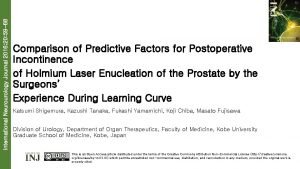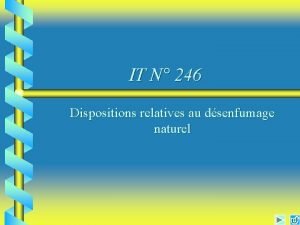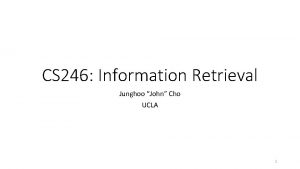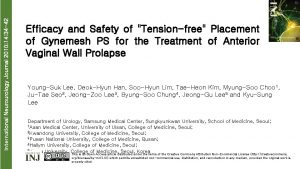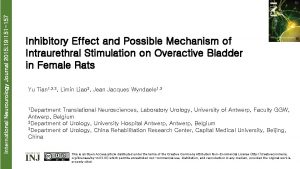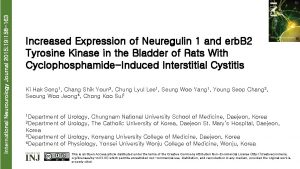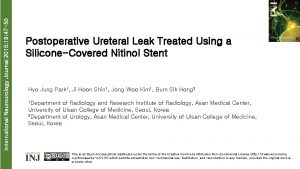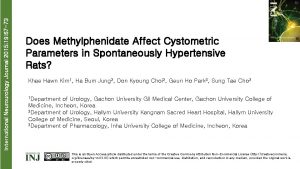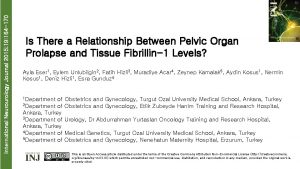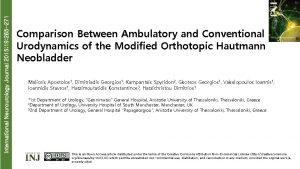International Neurourology Journal 2015 19 246 258 Efficacy




















- Slides: 20

International Neurourology Journal 2015; 19: 246 -258 Efficacy and Safety of Tension-Free Vaginal Tape-Secur Mini-Sling Versus Standard Midurethral Slings for Female Stress Urinary Incontinence: A Systematic Review and Meta-Analysis Wei Huang 1, 2, Tao Wang 1, 2, Huantao Zong 1, 2, Yong Zhang 1, 2 1 Urology Department, Beijing Tian Tan Hospital, Capital Medical University, Beijing, China 2 Neurourology Research Division, China National Clinical Research Center for Neurological Disease, Beijing, China This is an Open Access article distributed under the terms of the Creative Commons Attribution Non-Commercial License (http: //creativecommons. org/licenses/by-nc/3. 0/) which permits unrestricted non-commercial use, distribution, and reproduction in any medium, provided the original work is properly cited.

International Neurourology Journal 2015; 19: 246 -258 INTRODUCTION • To assess the efficacy and safety of tension-free vaginal tape (TVT)Secur for stress urinary incontinence (SUI). MATERIALS AND MRTHODS • A literature review was performed to identify all published trials of TVT -Secur. The search included the following databases: MEDLINE, Embase, and the Cochrane Controlled Trial Register.

International Neurourology Journal 2015; 19: 246 -258 RESULTS (1) • Seventeen publications involving a total of 1, 879 patients were used to compare TVT-Secur with tension-free obturator tape (TVT-O) and TVT. • We found that TVT-Secur had significant reductions in operative time, visual analog score for pain, and postoperative complications compared with TVT-O.

International Neurourology Journal 2015; 19: 246 -258 RESULTS (2) • Even though TVT-Secur had a significantly lower subjective cure rate (P<0. 00001), lower objective cure rate (P<0. 00001), and higher intraoperative complication rate, compared with TVT-O at 1 to 3 years, there was no significant difference between TVT-Secur and TVT-O in the subjective cure rate (odds ratio [OR], 0. 49; 95% confidence interval [CI], 0. 22– 1. 08; P=0. 08), objective cure rate (OR, 0. 49; 95% CI, 0. 22– 1. 09; P=0. 08), or complications at 3 to 5 years. • Moreover, TVT-Secur had significantly lower subjective and objective cure rates compared with TVT.

International Neurourology Journal 2015; 19: 246 -258 CONCLUSIONS • This meta-analysis indicates that TVT-Secur did not show an inferior efficacy and safety compared with TVTO for SUI in 3 to 5 years, even though displaying a clear tread toward a lower efficacy in 1 to 3 years. • Considering that the safety is similar, there are no advantages in using TVT-Secur.

International Neurourology Journal 2015; 19: 246 -258 Table. 1. Study and patient characteristics Study Therapy in experimental group Therapy in control group Tommaselli et al. (2010) [16] TVT-Secur TVT-O Hinoul et al. (2011) [17] TVT-Secur Wang et al. (2011) [18] Country Sample size Duration of treatment (mo) Inclusion population Experimental Control Italy 38 37 12 SUI lasting for at least 2 yr as diagnosed by clinical evaluation and urodynamics and age>40 yr TVT-O Belgium, the Netherlands 97 98 12 All patients in whom SUI could be objectified during clinical and/or urodynamic examination TVT-Secur TVT-O China 34 36 12 Women with SUI as diagnosed by clinical evaluation and urodynamics Wang et al. (2011) [18] TVT-Secur TVT China 34 32 12 Women with SUI as diagnosed by clinical evaluation and urodynamics Masata et al. (2012) [19] TVT-Secur TVT-O Czech Republic 129 68 24 Women with urodynamic SUI, failed conservative therapy, >18 yr and agreed to postoperative follow-up Hota et al. (2012) [20] TVT-Secur TVT-O USA 43 44 12 Women with SUI with an impact on Qo. L, positive CST during urodynamics Barber et al. (2012) [21] TVT-Secur TVT USA 136 127 12 Women at least 21 yr of age with SUI on multichannel urodynamics, desire for surgical treatment, concurrent surgical treatment of prolapse Andrada Hamer et al. (2013) [22] TVT-Secur TVT Sweden 64 69 12 Primary SUI or MUI with predominant stress, >18 yr of age and no wish for further pregnancy, ≥ 3 -m. L leakage on pad test, positive CST Tommaselli et al. (2013) [11] TVT-Secur TVT-O Italy 77 77 36 Women with SUI, diagnosed clinically and by urodynamics, age>30 yr, failed PFMT Tommaselli et al. (2015) [23] TVT-Secur TVT-O Italy 77 77 63 Women with SUI, diagnosed clinically and by urodynamics, age>30 yr, failed PFMT Maslow et al. (2014) [24] TVT-Secur TVT-O Canada 56 50 12 Women with symptoms of SUI and a positive cough test, which required surgical management Oliveira et al. (2011) [25] TVT-Secur TVT-O Portugal 30 30 12 Women with clinically and uro dynamically proven SUI associated with urethral hypermobility Ross et al. (2014) [26] TVT-Secur TVT Canada 40 34 12 Women leaked urine with increased abdominal pressure, and were suitable for either type of surgery Bianchi-Ferraro et al. (2013) [27] TVT-Secur TVT-O Brazil 66 56 12 Women presenting SUI symptoms demonstrated by stress test and urodynamics Bianchi-Ferraro et al. (2014) [12] TVT-Secur TVT-O Brazil 66 56 24 Women presenting SUI symptoms demonstrated by stress test and urodynamics Jeong et al. (2010) [28] TVT-Secur TVT-O Korea 31 33 12 Women presenting SUI symptoms demonstrated by stress test and urodynamics Neuman et al. (2011) [13] TVT-Secur TVT-O Israel 79 73 36 A diagnosis of SUI based on the patient’s personal history and a positive cough test with the bladder holding 300 to 400 m. L Pushkar et al. (2011) [29] TVT-Secur TVT-O Russia 45 50 12 Women with primary SUI or MUI with predominant stress, age>18 yr, positive CST TVT, tension-free vaginal tape; TVT-O, tension-free obturator tape; SUI, stress urinary incontinence; Qo. L, quality of life; CST, cough stress test; MUI, mixed urinary incontinence; PFMT, pelvic floor muscle training.

International Neurourology Journal 2015; 19: 246 -258 Table. 2. Quality assessment of individual study Study Allocation sequence generation Allocation concealment Tommaselli et al. (2010) [16] A B Blinding Loss to follow-up A 9 Calculation of sample size YES Student t-test, Shapiro-Wilk test Statistical analysis Intention-to-treat analysis YES B Hinoul et al. (2011) [17] A A A 34 YES Mann-Whitney test, chi-square test YES A Wangetal. (2011) [18] A A A 6 YES Paired t-test, chi-square test YES A Masata et al. (2012) [19] A A A 0 YES Fisher exact test YES A Hotaetal. (2012) [20] A A B 6 YES t-test, Mann-Whitney U-test, or chi-square test YES B Barber et al. (2012) [21] A A A 14 YES Paired t-test, Wilcoxon rank-sum test YES A Andrada Hamer et al. (2013) [22] A A A 4 YES Chi-square test, Wilcoxon test, Mann-Whitney test or Kruskal-Wallis test YES A Tommaselli et al. (2013) [11] A A B 9 YES Mann-Whitney test, Wilcoxon test, or chisquare test YES B Tommaselli et al. (2015) [23] A A B 34 YES Mann-Whitney test, Wilcoxon test, or chisquare test YES B Maslowetal. (2014) [24] A A A 2 YES Chi-square test, Kruskal-Wallis test, Wilcoxon test, and Fisher exact test YES A Oliveira et al. (2011) [25] A A A 0 YES Fisher exact test YES A Ross et al. (2014) [26] A A A 6 YES Fisher exact test, Mann-Whitney U test and ttest YES A Bianchi-Ferraro et al. (2013) [27] A A A 5 YES Mann-Whitney U-test, Student t-test, Fisher exact test YES A Bianchi-Ferraro et al. (2014) [12] A A A 7 YES Mann-Whitney U-test, Student t-test, Fisher exact test YES A Jeong et al. (2010) [28] A B B 0 YES Student t-test, chi-square test, and Fisher exact test YES B Neuman et al. (2011) [13] A A B 6 YES t-test, chi-square test or Fisher exact test and Mc. Nemar test YES B Pushkar et al. (2011) [29] A A A 3 YES t-test, chi-square test or Fisher exact test and the Mc. Nemar test YES A A, all quality criteria met (adequate) - low risk of bias; B, one or more of the quality criteria only partly met (unclear) - moderate risk of bias; C, one or more criteria not met (inadequate or not used) - high risk of bias. Level of quality

International Neurourology Journal 2015; 19: 246 -258 Fig. 1. The flow diagram of the study selection. RCT, randomized controlled trial.

International Neurourology Journal 2015; 19: 246 -258 Fig. 2. Funnel plot of the studies represented in our meta-analysis. SE, standard error; OR, odds ratio.

International Neurourology Journal 2015; 19: 246 -258 Fig. 3

International Neurourology Journal 2015; 19: 246 -258 Fig. 3. Operative time, visual analog score (VAS) score (postoperative day 1) (TVT-Secur vs. TVT-O). TVT, tension-free vaginal tape; TVT-O, tensionfree obturator tape; SD, standard deviation; IV, inverse variance; Fixed, fixed effect model; CI, confidence interval; df, degrees of freedom.

International Neurourology Journal 2015; 19: 246 -258 Fig. 4

International Neurourology Journal 2015; 19: 246 -258 Fig. 4. Subjective and objective cure rate at 1– 3 years and 3– 5 years (TVTSecur vs. TVT-O). TVT, tension-free vaginal tape; TVT-O, tension-free obturator tape; M-H, Mantel-Haenszel method; Fixed, fixed effect model; CI, confidence interval; df, degrees of freedom.

International Neurourology Journal 2015; 19: 246 -258 Fig. 5

International Neurourology Journal 2015; 19: 246 -258 Fig. 5. Bleeding greater than 100 m. L, reoperation for stress urinary incontinence (SUI), and de novo urgency (TVT-Secur vs. TVT-O). TVT, tension-free vaginal tape; TVT-O, tension-free obturator tape; M-H, Mantel -Haenszel method; Fixed, fixed effect model; CI, confidence interval; df, degrees of freedom.

International Neurourology Journal 2015; 19: 246 -258 Fig. 6

International Neurourology Journal 2015; 19: 246 -258 Fig. 6. Complications: intraoperative or postoperative complications at 1– 3 years, postoperative complications at 3– 5 years (TVT-Secur vs. TVT-O). TVT, tension-free vaginal tape; TVT-O, tension-free obturator tape; M-H, Mantel-Haenszel method; Fixed, fixed effect model; CI, confidence interval; df, degrees of freedom.

International Neurourology Journal 2015; 19: 246 -258 Fig. 7

International Neurourology Journal 2015; 19: 246 -258 Fig. 7. Subjective and objective cure rate (TVT-Secur vs. TVT). TVT, tension -free vaginal tape; M-H, Mantel-Haenszel method; Fixed, fixed effect model; CI, confidence interval; df, degrees of freedom.

International Neurourology Journal 2015; 19: 246 -258 Fig. 8. Complications (TVT-Secur vs. TVT). TVT, tension-free vaginal tape; M-H, Mantel-Haenszel method; Fixed, fixed effect model; CI, confidence interval; df, degrees of freedom.
 International neurourology journal
International neurourology journal The verbs ser and estar (p. 258) answers
The verbs ser and estar (p. 258) answers 258x203
258x203 Iis leonardo da vinci roma
Iis leonardo da vinci roma Section 258 of mlrc
Section 258 of mlrc Rd 258/99
Rd 258/99 Emily dickinson poem 258
Emily dickinson poem 258 Gog 258
Gog 258 Mining massive datasets
Mining massive datasets Mining of massive datasets stanford
Mining of massive datasets stanford Redondear a los centesimos 13 221
Redondear a los centesimos 13 221 En un zoológico hay 246 aves
En un zoológico hay 246 aves Place value of 246
Place value of 246 Cs 246
Cs 246 It 246
It 246 Junghoo cho ucla
Junghoo cho ucla Round 246 to the nearest hundred
Round 246 to the nearest hundred Afman 10-246
Afman 10-246 Ds p van veen
Ds p van veen 246 regel diabetes
246 regel diabetes Drug efficacy
Drug efficacy
